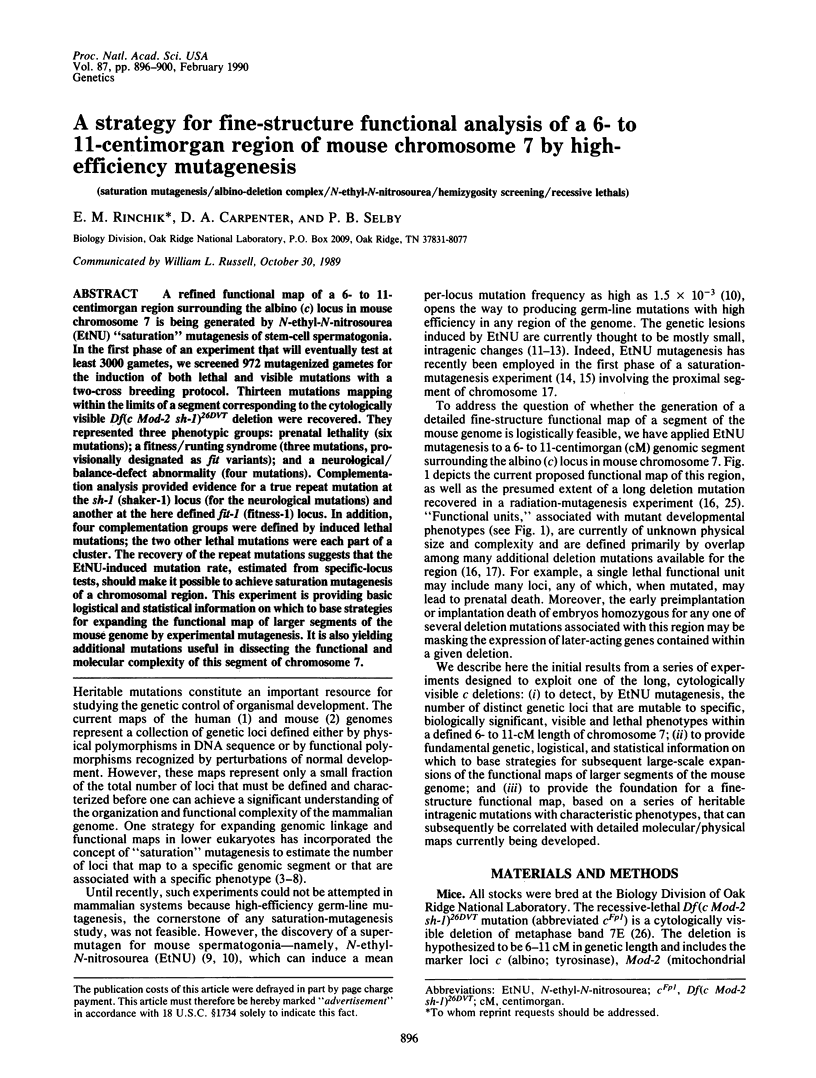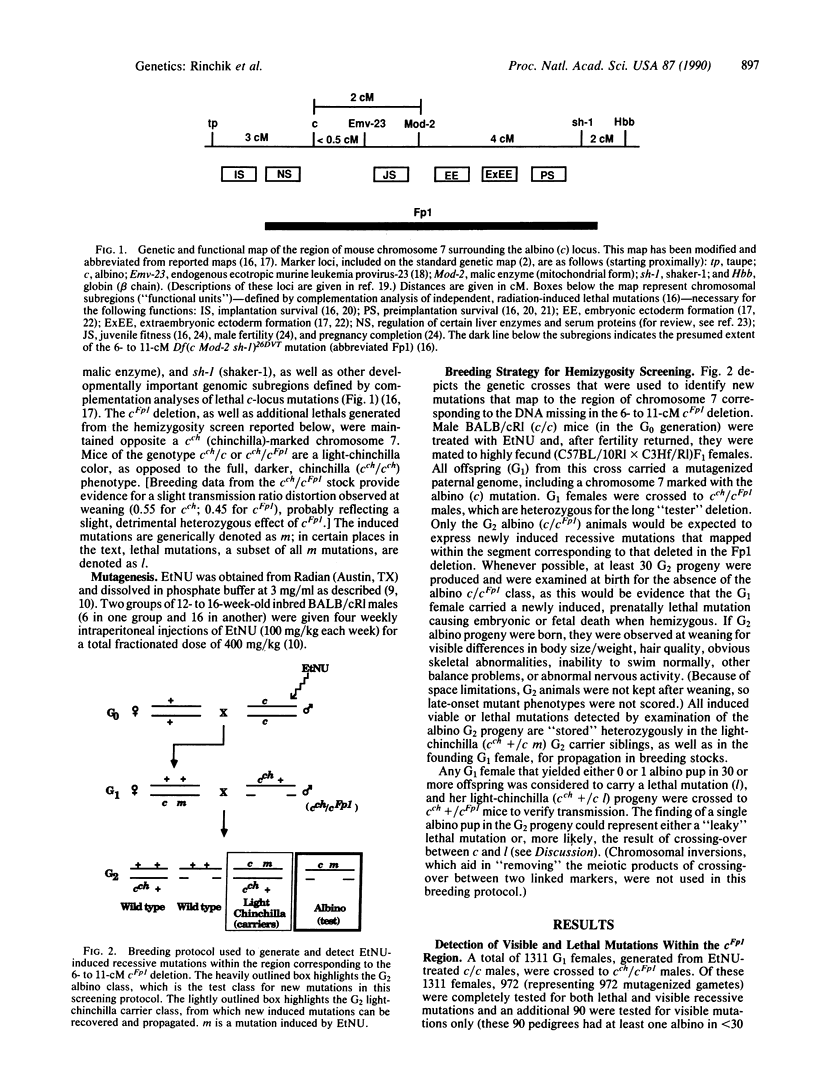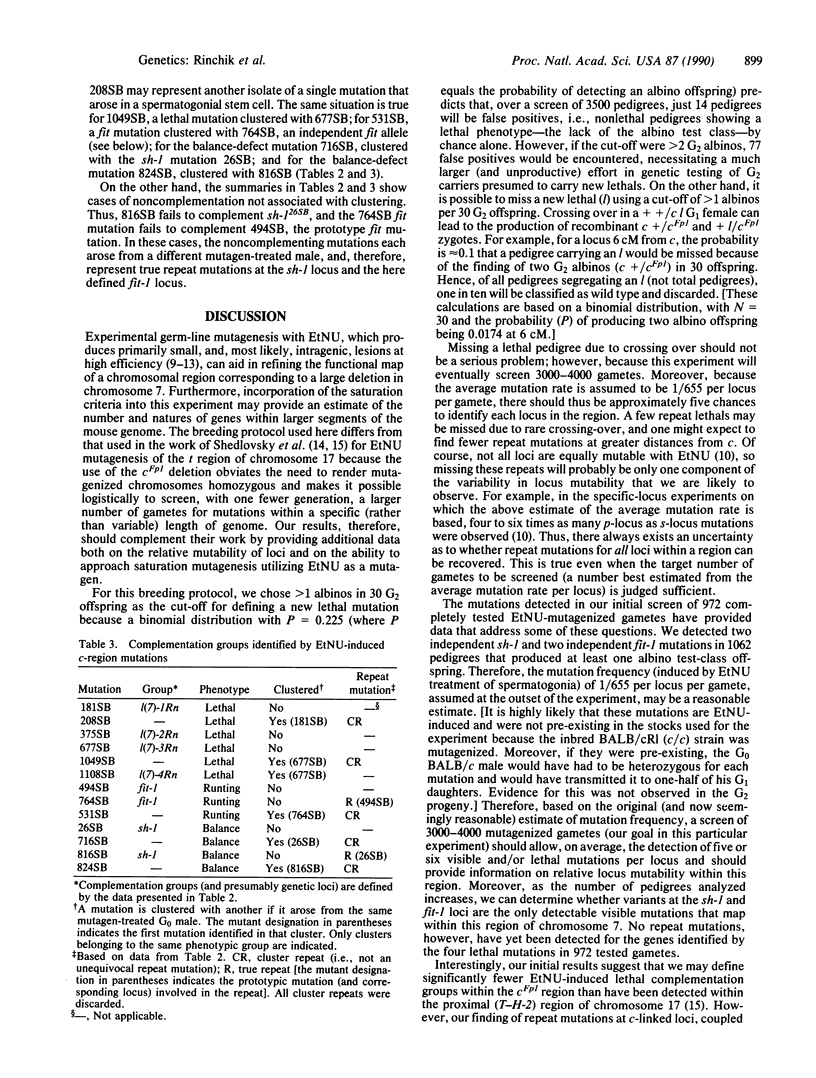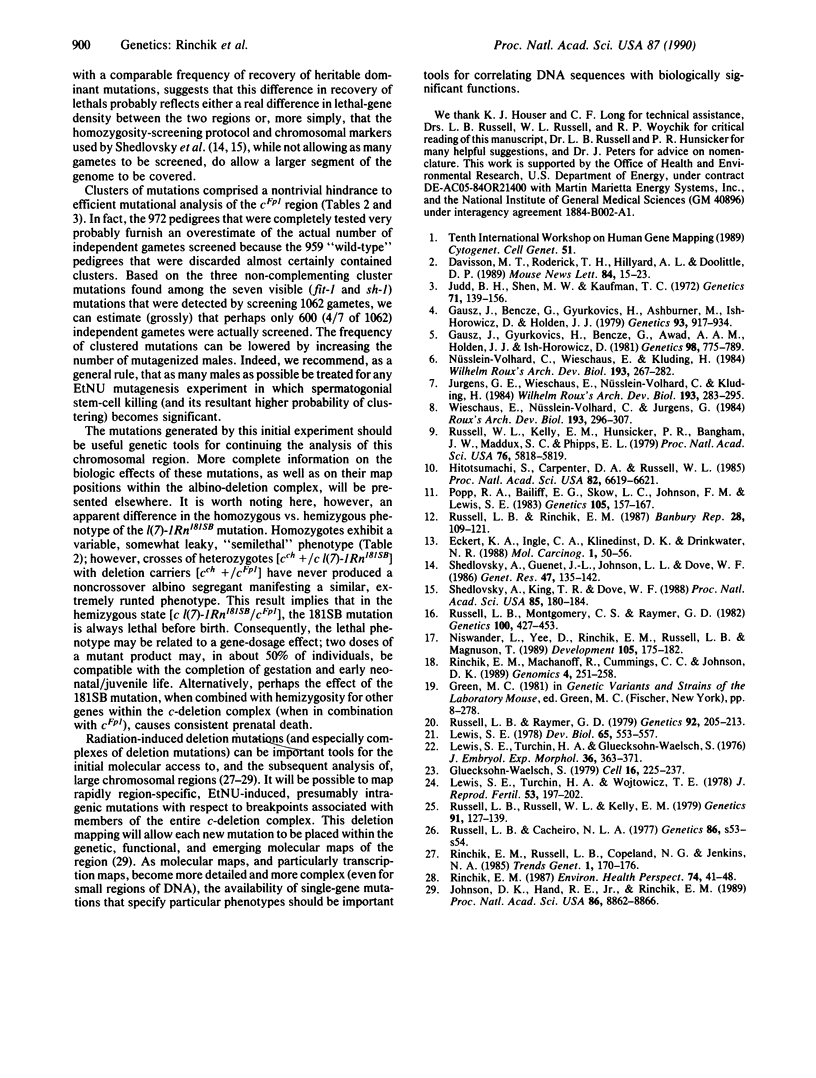Abstract
A refined functional map of a 6- to 11-centimorgan region surrounding the albino (c) locus in mouse chromosome 7 is being generated by N-ethyl-N-nitrosourea (EtNU) "saturation" mutagenesis of stem-cell spermatogonia. In the first phase of an experiment that will eventually test at least 3000 gametes, we screened 972 mutagenized gametes for the induction of both lethal and visible mutations with a two-cross breeding protocol. Thirteen mutations mapping within the limits of a segment corresponding to the cytologically visible Df(c Mod-2 sh-1)26DVT deletion were recovered. They represented three phenotypic groups: prenatal lethality (six mutations); a fitness/runting syndrome (three mutations, provisionally designated as fit variants); and a neurological/balance-defect abnormality (four mutations). Complementation analysis provided evidence for a true repeat mutation at the sh-1 (shaker-1) locus (for the neurological mutations) and another at the here defined fit-1 (fitness-1) locus. In addition, four complementation groups were defined by induced lethal mutations; the two other lethal mutations were each part of a cluster. The recovery of the repeat mutations suggests that the EtNU-induced mutation rate, estimated from specific-locus tests, should make it possible to achieve saturation mutagenesis of a chromosomal region. This experiment is providing basic logistical and statistical information on which to base strategies for expanding the functional map of larger segments of the mouse genome by experimental mutagenesis. It is also yielding additional mutations useful in dissecting the functional and molecular complexity of this segment of chromosome 7.
Full text
PDF




Selected References
These references are in PubMed. This may not be the complete list of references from this article.
- Eckert K. A., Ingle C. A., Klinedinst D. K., Drinkwater N. R. Molecular analysis of mutations induced in human cells by N-ethyl-N-nitrosourea. Mol Carcinog. 1988;1(1):50–56. doi: 10.1002/mc.2940010111. [DOI] [PubMed] [Google Scholar]
- Gausz J., Bencze G., Gyurkovics H., Ashburner M., Ish-Horowicz D., Holden J. J. Genetic Characterization of the 87c Region of the Third Chromosome of DROSOPHILA MELANOGASTER. Genetics. 1979 Dec;93(4):917–934. doi: 10.1093/genetics/93.4.917. [DOI] [PMC free article] [PubMed] [Google Scholar]
- Gausz J., Gyurkovics H., Bencze G., Awad A. A., Holden J. J., Ish-Horowicz D. Genetic characterization of the region between 86F1,2 and 87B15 on chromosome 3 of Drosophila melanogaster. Genetics. 1981 Aug;98(4):775–789. doi: 10.1093/genetics/98.4.775. [DOI] [PMC free article] [PubMed] [Google Scholar]
- Gluecksohn-Waelsch S. Genetic control of morphogenetic and biochemical differentiation: lethal albino deletions in the mouse. Cell. 1979 Feb;16(2):225–237. doi: 10.1016/0092-8674(79)90001-1. [DOI] [PubMed] [Google Scholar]
- Hitotsumachi S., Carpenter D. A., Russell W. L. Dose-repetition increases the mutagenic effectiveness of N-ethyl-N-nitrosourea in mouse spermatogonia. Proc Natl Acad Sci U S A. 1985 Oct;82(19):6619–6621. doi: 10.1073/pnas.82.19.6619. [DOI] [PMC free article] [PubMed] [Google Scholar]
- Johnson D. K., Hand R. E., Jr, Rinchik E. M. Molecular mapping within the mouse albino-deletion complex. Proc Natl Acad Sci U S A. 1989 Nov;86(22):8862–8866. doi: 10.1073/pnas.86.22.8862. [DOI] [PMC free article] [PubMed] [Google Scholar]
- Judd B. H., Shen M. W., Kaufman T. C. The anatomy and function of a segment of the X chromosome of Drosophila melanogaster. Genetics. 1972 May;71(1):139–156. doi: 10.1093/genetics/71.1.139. [DOI] [PMC free article] [PubMed] [Google Scholar]
- Lewis S. E. Developmental analysis of lethal effects of homozygosity for the c25H deletion in the mouse. Dev Biol. 1978 Aug;65(2):553–557. doi: 10.1016/0012-1606(78)90052-0. [DOI] [PubMed] [Google Scholar]
- Lewis S. E., Turchin H. A., Gluecksohn-Waelsch S. The developmental analysis of an embryonic lethal (C6H) in the mouse. J Embryol Exp Morphol. 1976 Oct;36(2):363–371. [PubMed] [Google Scholar]
- Lewis S. E., Turchin H. A., Wojtowicz T. E. Fertility studies of complementing genotypes at the albino locus of the mouse. J Reprod Fertil. 1978 Jul;53(2):197–202. doi: 10.1530/jrf.0.0530197. [DOI] [PubMed] [Google Scholar]
- Niswander L., Yee D., Rinchik E. M., Russell L. B., Magnuson T. The albino-deletion complex in the mouse defines genes necessary for development of embryonic and extraembryonic ectoderm. Development. 1989 Jan;105(1):175–182. doi: 10.1242/dev.105.1.175. [DOI] [PubMed] [Google Scholar]
- O'Donnell J., Mandel H. C., Krauss M., Sofer W. Genetic and cytogenetic analysis of the Adh region in Drosophila melanogaster. Genetics. 1977 Jul;86(3):553–566. doi: 10.1093/genetics/86.3.553. [DOI] [PMC free article] [PubMed] [Google Scholar]
- Popp R. A., Bailiff E. G., Skow L. C., Johnson F. M., Lewis S. E. Analysis of a mouse alpha-globin gene mutation induced by ethylnitrosourea. Genetics. 1983 Sep;105(1):157–167. doi: 10.1093/genetics/105.1.157. [DOI] [PMC free article] [PubMed] [Google Scholar]
- Rinchik E. M., Machanoff R., Cummings C. C., Johnson D. K. Molecular cloning and mapping of the ecotropic leukemia provirus Emv-23 provides molecular access to the albino-deletion complex in mouse chromosome 7. Genomics. 1989 Apr;4(3):251–258. doi: 10.1016/0888-7543(89)90328-5. [DOI] [PubMed] [Google Scholar]
- Rinchik E. M. Molecular analysis of heritable mouse mutations. Environ Health Perspect. 1987 Oct;74:41–48. doi: 10.1289/ehp.877441. [DOI] [PMC free article] [PubMed] [Google Scholar]
- Russell L. B., Montgomery C. S., Raymer G. D. Analysis of the albino-locus region of the mouse: IV. Characterization of 34 deficiencies. Genetics. 1982 Mar;100(3):427–453. doi: 10.1093/genetics/100.3.427. [DOI] [PMC free article] [PubMed] [Google Scholar]
- Russell L. B., Raymer G. D. Analysis of the albino-locus region of the mouse. III. Time of death of prenatal lethals. Genetics. 1979 May;92(1):205–213. doi: 10.1093/genetics/92.1.205. [DOI] [PMC free article] [PubMed] [Google Scholar]
- Russell L. B., Russell W. L., Kelly E. M. Analysis of the albino-locus region of the mouse. I. Origin and viability. Genetics. 1979 Jan;91(1):127–139. doi: 10.1093/genetics/91.1.127. [DOI] [PMC free article] [PubMed] [Google Scholar]
- Russell W. L., Kelly E. M., Hunsicker P. R., Bangham J. W., Maddux S. C., Phipps E. L. Specific-locus test shows ethylnitrosourea to be the most potent mutagen in the mouse. Proc Natl Acad Sci U S A. 1979 Nov;76(11):5818–5819. doi: 10.1073/pnas.76.11.5818. [DOI] [PMC free article] [PubMed] [Google Scholar]
- Shedlovsky A., Guenet J. L., Johnson L. L., Dove W. F. Induction of recessive lethal mutations in the T/t-H-2 region of the mouse genome by a point mutagen. Genet Res. 1986 Apr;47(2):135–142. doi: 10.1017/s0016672300022977. [DOI] [PubMed] [Google Scholar]
- Shedlovsky A., King T. R., Dove W. F. Saturation germ line mutagenesis of the murine t region including a lethal allele at the quaking locus. Proc Natl Acad Sci U S A. 1988 Jan;85(1):180–184. doi: 10.1073/pnas.85.1.180. [DOI] [PMC free article] [PubMed] [Google Scholar]


